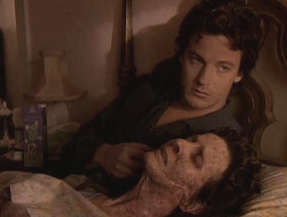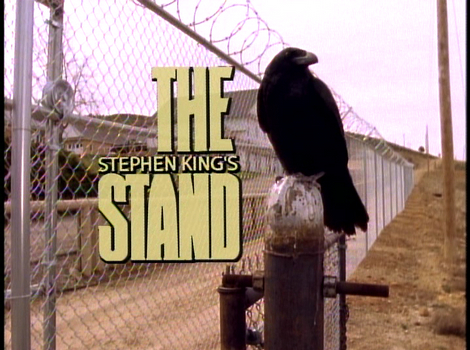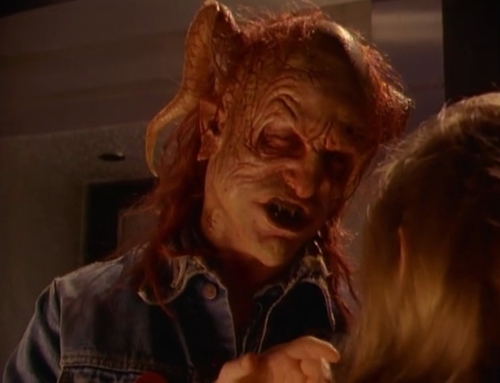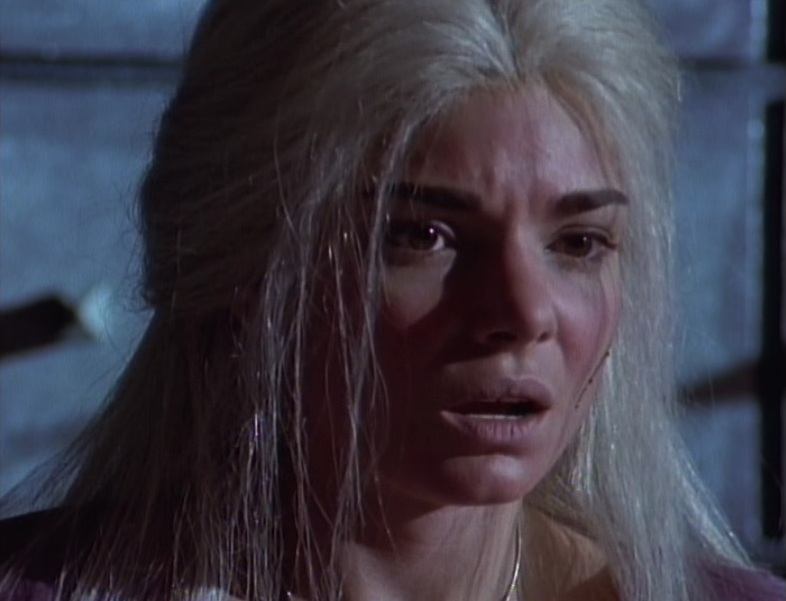It’s October. With Halloween hot on our heels, we thought it appropriate to take a look at legendary horror author Stephen King’s best, worst, and strangest translations from page to screen. Baby, can you dig your man?
I first saw the four-part TV miniseries adaptation of Stephen King’s apocalyptic novel The Stand in the summer of 2006, when I was seventeen. I sat down with my father and my best friend Mike Pfeiffer, both Stephen King die-hards who cherished the original novel. I was never going to read 1400 pages of anything, so I opted for the screen version, and they obliged. We watched the miniseries—all six hours of it—in one sitting. It’s an enormous story, in which a militarized super-flu wipes out nearly all of humanity, and the survivors engage in a divinely-inspired struggle to determine whether the forces or good or evil will be the ones to rebuild the world. It’s the kind of tale the word “epic” was invented to describe.
I remember enjoying the series on my first viewing, not feeling particularly scared but certainly enthralled. Pfeiff and I talked a lot about The Stand that summer, devising chilling friend-fiction imagining what our journey across the corpse-ridden wastes would be like. That’s around when it started to creep up on me.
One night, about a month later, I dreamed that I was caring for an assortment of classmates, family, and friends in my parents’ basement, each of them struck with the same persistent illness. Their eyes were glassy, their glands were swollen out of their necks, their skin glistened with a sticky mix of sweat and phlegm. And I would stand over them, watching them suffer, unable to do a thing but wonder why I felt perfectly healthy.
That morning I woke up, scared out of my mind, convinced that I’d had a vision, like the characters in The Stand, or worse: that I’d brought the killer disease back with me from the dream. I went to work with my father as usual, pretending everything was normal, but in my head I was keeping track of every person I shared a room with, terrified that I’d just killed them with a breath. I went home early and holed up in the house, which I refused to leave for the next three days.
What I’m saying is The Stand fucked me up real bad. It forced me to accept a few unfortunate truths:
- There are definitely government compounds in the desert where they store and experiment with super-viruses, and there’s nothing I can do about it.
- One day I’m going to die, and there’s nothing I can do about it.
- If I’m lucky, I’m going to live long enough to watch some of the people I love die, and there’ll be nothing I can do about it.
- I’m maybe not entirely right in the head, and there’s not a whole lot I can do about that, either.
I wanted you all to understand the importance that The Stand has for me before I go any further. Though until now I haven’t been able to bring myself to watch it a second time, it remains one of the most formative works to who I am as a person—which is why it sort of pains me to say that, as a work of cinema, it is not very good.
From the outset, the TV version of The Stand has as much going for it as it does against it. In the plus column: it’s adapted for the screen by Stephen King himself, ensuring that both the events and the spirit of the novel would remain intact; it stars a number of big names, like Gary Sinise, Molly Ringwald, Rob Lowe, and a very memorable cameo by Kathy Bates. In the minus: director ‘s next most notable work is Critters 2, and most damning of all, it was made in 1994, before audiences started expecting television to look good. It aired concurrent with the first season of The X-Files, and its effects and cinematography are on about the same level. (Mind you, The Stand was a major television event on ABC, while The X-Files was a new series on the fledgling Fox network.)

The plague make-up, however, is the stuff of my literal nightmares. I needed a stiff drink to get through this.
That said, The Stand starts off incredibly well. Part One: “The Plague,” is a terrifying portrayal of a viral apocalypse, even in a post-The Walking Dead, post-Dawn of the Planet of the Apes world. “The Plague” cuts between lead characters across the country, as well as to the government agencies tasked with containing the outbreak and covering their asses. As the virus spreads out of control, so does the government’s response, placing a higher priority on avoiding blame than actually protecting the populace. To say that The Stand presents a cynical view of the United States military would be a colossal understatement, but sadly it plays as very convincing. The disease itself is frightening in its realism, as well, aided by some excellent make-up effects.
The Stand is a supernatural horror saga, but “The Plague” benefits greatly by staying grounded in reality, only providing glimpses of the biblical scale of the story. Where The Stand stumbles most is in its presentation of the unreal; while the flu makeup effects are shudder-inducing, any time demonic emissary Randal Flagg (Jamey Sheridan) appears in his true form, horns and pointy ears and sharp pointy teeth and all, he looks like a lesser Buffy villain. Flagg’s laughable appearance is compounded by the fact that only his face and hands change—he’s still rocking double denim. Likewise, Flagg’s angelic counterpart, the 106-year-old Mother Abigail (Ruby Dee), is so made up that she looks more like a Jim Henson creation than a human being, which isn’t helped by the fact that the character is basically Yoda.
Indeed, few of The Stand‘s characters manage to assert themselves as much more than archetypes. God’s chosen people include Stu “Country Don’t Mean Dumb” Redman (Gary Sinise), Frannie “Girl Next Door” Goldsmith (Molly Ringwald), Larry “Kind of an Asshole but Not Really, Whatever” Underwood (Adam Storke), and Nick “Deaf & Dumb Sweetheart” Andros (Rob Lowe). Because this is a Stephen King story, we have to have our magic black people (both Mother Abigail, and a nameless prophet in Part One portrayed by Kareem Abdul-Jabbar) and a sweet mentally disabled guy, Tom Cullen (Bill Fagerbakke, the voice of Patrick on Spongebob). Randal Flagg’s band of evildoers includes ex-con Lloyd Hendry (Miguel Ferrer) and a schizophrenic firestarter known only as Trashcan Man (Matt Frewer), and while they each own any scene they’re in, neither has much depth. For the most part, the good guys are good, and the bad guys are bad.
There are a couple of ‘tweeners in The Stand‘s cast. Harold Lauder is a bullied nerd who survives the apocalypse, but being one of the last men on Earth doesn’t make him any more attractive to longtime crush Frannie. Harold is defined by his jealousy and entitlement—friend of the site @Reichenby described him as a “every GG ever” and that pretty much hits the nail on the head. He’s not the least bit sympathetic, so his unfortunate end doesn’t hit terribly hard. On the other hand, there’s Nadine Cross (Laura San Giacomo), a young woman who seems to have had a tough time of it even before the world ended, and is seduced by Flagg. After being convinced to commit mass murder, Nadine then gets raped and impregnated by Flagg and loses what’s left of her mind. Rather than bring demonspawn into the world, Nadine throws herself off a building. Nadine is basically the only character in The Stand who gets an arc, and it’s pretty damn brutal.
The Stand‘s six-hour (without commercials, mind you) runtime is a double-edged sword. On the one hand, the three books that make up The Stand get divided into four solid ninety-minute segments, virtually movies in their own right. While this is a great idea in theory, Part Two: “The Dreams” and Part Three: “The Betrayal” are both fairly uneventful, and could easily have been condensed into one segment. “The Plague” and the final act (also called “The Stand”) both move pretty briskly, while “The Dreams” and “The Betrayal” feel desperately padded at times. Must we spend two minutes watching Mother Abigail have a pointless one-sided conversation with God? How about watching the cast sing the entirety of “The Star-Spangled Banner” at their first town council meeting?
Parts Two and Three also suffer from not having a cohesive theme to tie them together. “The Plague” is about hubris, loss, family, and fate, as our great civilization crumbles and our lead characters witness the death of everything they know. “The Stand” is about faith, as four of our leads walk empty-handed from Boulder, Colorado to Las Vegas on a holy mission of peace, and Randall Flagg’s cult of selfishness falls apart as his followers stop believing in him one by one. Neither “The Dreams” nor “The Betrayal” feel like they’re about much of anything beneath the surface, aside from getting the characters in place for the finale. There may be more going on in the book, but it didn’t make it to the screen despite more than enough time to tell the story.
A feature film adaptation of The Stand has been in development hell for the past decade, and the latest word is that the film will be preceded by an eight-part cable miniseries, making the new version even longer than the original. While an increased budget and modern production values will certainly help sell the supernatural elements of the story, re-watching the ABC miniseries has me weary of any attempts to further expand The Stand on screen. Will I be watching? That depends on whether or not the nightmares come back.
Happy Halloween from Deadshirt.net.




